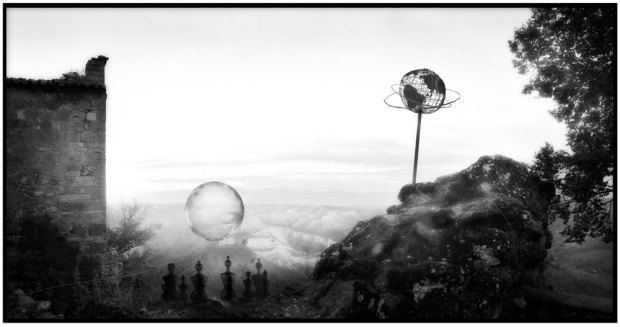In 1915 Marcel Duchamp presented objects in galleries that he had not created but rather 'identified' as having artistic merit. Since then, this very modern sensibility of seeing the mundane and taken for granted as unique artistic expression has had a great legacy in the arts. To me, This spirit of 'seeing' forms one of the essential pillars in the foundation of photography. When we focus our lens on the world we are making statements about what we think is important and significant in the world.

I saw this wall in a little town of Bagnoregio, Italy about 15 miles southwest of Orvieto. Not far from the place I shot Dark Dream of Umbria  At the time I was amazed by the richness of texture and form on a wall that the owners I'm sure considered very utilitarian and perhaps even an embarrassment. If the light had been not falling so fast I might have lingered for close ups, there is a veritable universe of landscapes nascent in this one wall of accidental frescoes and ready made objects. Some many facts and stories can be derived from this image. This is an old building with solid stone and plaster walls. To add electricity or plumbing it is usually necessary to run the wiring on either the inner our outer surface, because running it through the stone itself is highly impractical. Here we see electrical wires phone lines and perhaps internet connections lacing from room to room in an abstract pattern that shows an attempt at some order and neatness. I have seen other walls where every wire just sort of shoots on different random vectors from hole to hole, giving another style of abstraction entirely. So we know that some attempt at aesthetics was made here. The light tones of plaster probably demark where new plumbing was added--we can imagine jack hammers carving troughs for pipes that bring hot water to a structure that was built in a time of chamber pots and cisterns.
At the time I was amazed by the richness of texture and form on a wall that the owners I'm sure considered very utilitarian and perhaps even an embarrassment. If the light had been not falling so fast I might have lingered for close ups, there is a veritable universe of landscapes nascent in this one wall of accidental frescoes and ready made objects. Some many facts and stories can be derived from this image. This is an old building with solid stone and plaster walls. To add electricity or plumbing it is usually necessary to run the wiring on either the inner our outer surface, because running it through the stone itself is highly impractical. Here we see electrical wires phone lines and perhaps internet connections lacing from room to room in an abstract pattern that shows an attempt at some order and neatness. I have seen other walls where every wire just sort of shoots on different random vectors from hole to hole, giving another style of abstraction entirely. So we know that some attempt at aesthetics was made here. The light tones of plaster probably demark where new plumbing was added--we can imagine jack hammers carving troughs for pipes that bring hot water to a structure that was built in a time of chamber pots and cisterns.  Also the decision was made to protect the inner surfaces of this house at the price of 'violating' the outer surface. So one can assume that the inside of this dwelling might be very nicely decorated and quite the opposite of what we see here. Perhaps all these decisions were made when the wall was nicely covered by the neighbors house which was torn/ fell down, a humorous and embarrassing unveiling of family secrets, rather like having the walls of your garage go suddenly transparent. Here's the original image from the camera. What do you think?
Also the decision was made to protect the inner surfaces of this house at the price of 'violating' the outer surface. So one can assume that the inside of this dwelling might be very nicely decorated and quite the opposite of what we see here. Perhaps all these decisions were made when the wall was nicely covered by the neighbors house which was torn/ fell down, a humorous and embarrassing unveiling of family secrets, rather like having the walls of your garage go suddenly transparent. Here's the original image from the camera. What do you think?
The nice curtains in the upper window also suggest a pleasant interior space. And each window here also tells a story. The owners have a nice existence on the upper floors, rent out the lower left to a nice student and Benzo the village ogre lives in the shadows behind the lower right. We can go on forever making up stories about who lives here and how.
I could even see moving this entire wall to MOMA to make a monumental ready-made statement. In the meantime I offer you this photograph. Since it was taken 10 years ago, one can only imagine what new additions have been added to this utilitarian jambalaya, or perhaps a new building hides this wall or maybe the building is gone all together. Ahah! Sounds like a good adventure to go find out and a great excuse to go back to beautiful Italy!